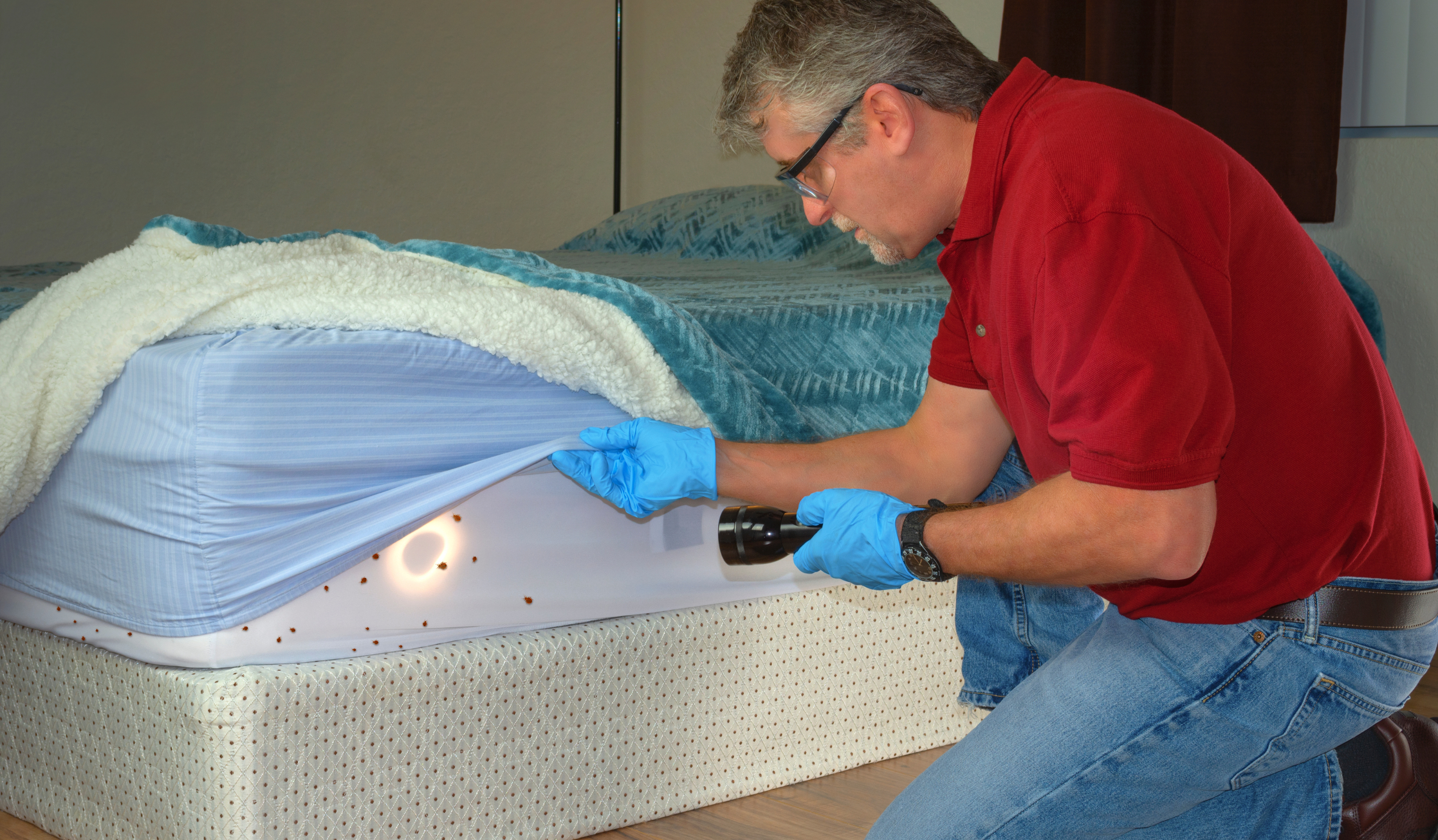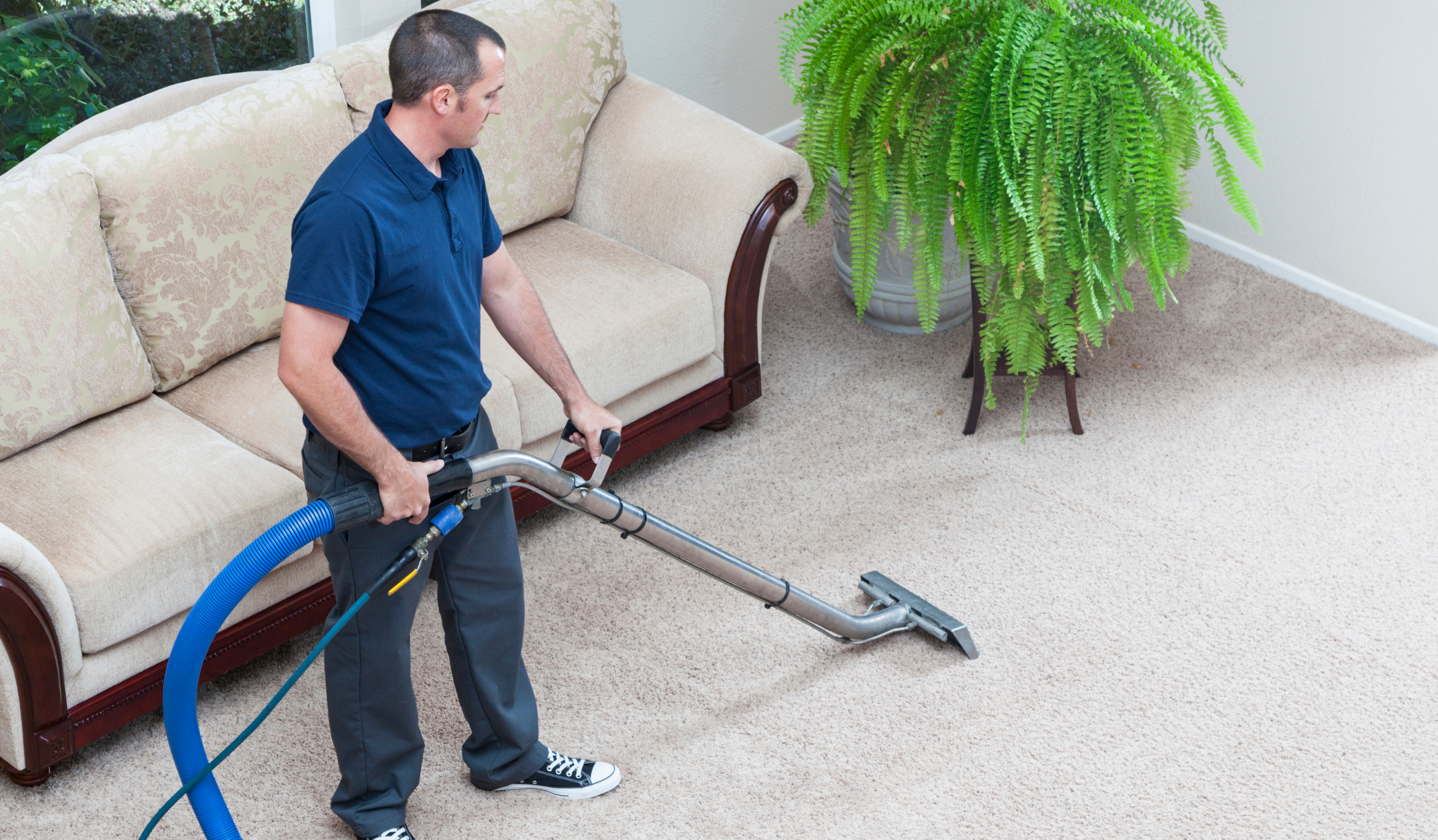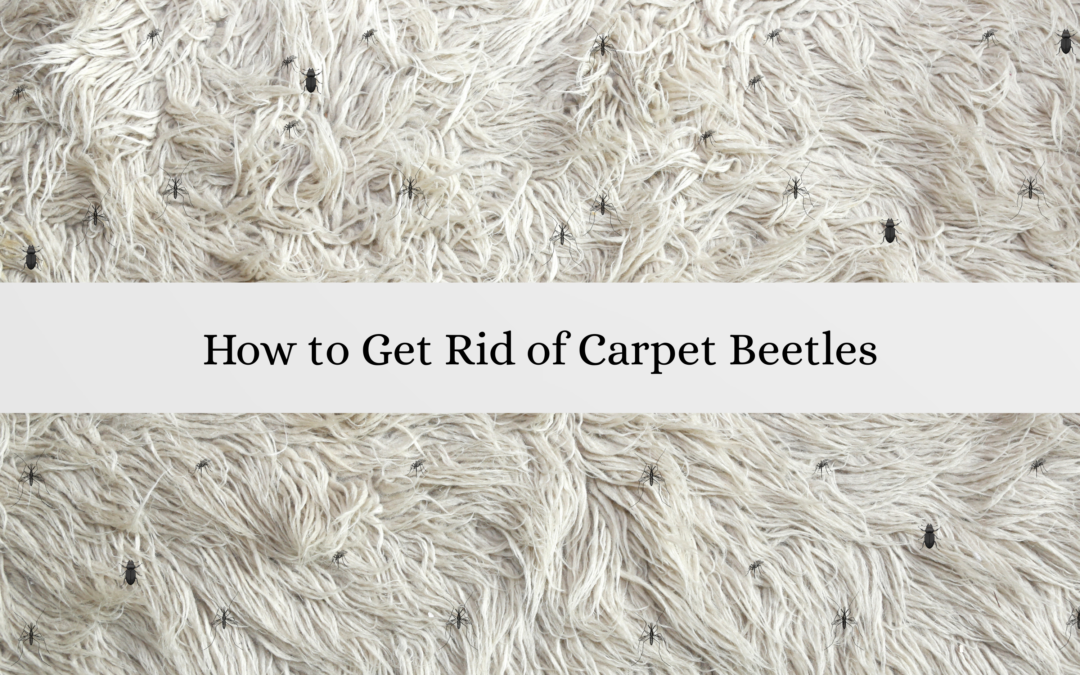One of the most effective first steps in treating an infestation is a thorough carpet cleaning. Deep vacuuming combined with professional carpet steam cleaning can help remove hidden larvae and eggs embedded in fibers. Steam penetrates deep into the carpet pile, using high temperatures to kill pests at all stages of their life cycle. Regular cleaning not only removes active beetles but also eliminates the lint, pet hair, and debris that attract them in the first place.
How to Identify a Carpet Beetle Infestation
The first step in removing carpet beetles is knowing you have them. Unlike moths, carpet beetles are often mistaken for harmless household bugs. However, their larvae are the real troublemakers, chewing through fabrics and leaving behind damage.
Common signs of a carpet beetle infestation include:
- Small, irregular holes in clothing, rugs, or upholstery
- Shed larval skins near baseboards or in dark corners
- Tiny, oval-shaped insects crawling or flying near windows
- Accumulated lint, pet hair, or debris—often a food source for larvae
If you notice these signs, a deeper inspection is needed to locate where they’re nesting and feeding.
Types of Carpet Beetles

Several species of carpet beetles are known to infest homes, and while they may look small and harmless, they can cause extensive damage to natural fibers over time. Identifying the specific type of beetle you’re dealing with is essential, as it can help you choose the most effective treatment plan and prevention strategy. Below are the most common types found in households.
Varied Carpet Beetle
The Varied Carpet Beetle is one of the most widespread and recognizable species. Adults are tiny—usually about 1/8 inch long—and have a distinctive mottled appearance with white, brown, and yellow scales on their backs. These beetles are often found near windowsills or light sources, as they are attracted to sunlight. While the adults feed on pollen outdoors, their larvae can wreak havoc indoors.
The larvae are brown and hairy, feeding on a wide range of materials including wool, silk, feathers, leather, and even pet hair. Because they hide in dark, undisturbed areas like under furniture or in closets, infestations can go unnoticed until significant damage occurs.
Furniture Carpet Beetles
Furniture Carpet Beetles are rounder and slightly larger than their varied counterparts, ranging up to 3/16 inch long. Their coloration is also mottled but typically includes white, orange, and black patterns. These beetles are commonly found in upholstered furniture—hence their name—and often lay their eggs in crevices where larvae will have immediate access to natural fibers. The larvae are carrot-shaped, reddish-brown, and covered with bristle-like hairs.
In addition to upholstery, they also target stored clothing, blankets, and any other items containing wool or silk. If you’ve noticed holes in furniture fabric or unexplained thinning of materials, furniture carpet beetles may be the culprit.
Black Carpet Beetle
The Black Carpet Beetle is considered one of the most destructive species when it comes to household infestations. Adults are shiny black or dark brown and oval-shaped, growing slightly larger than other carpet beetles—up to 1/4 inch long. Their larvae are long, carrot-shaped, and dark reddish-brown with bristly hairs, and they tend to grow bigger than the larvae of other species. Black carpet beetle larvae are particularly aggressive feeders and can chew through a wide variety of organic materials, including wool, feathers, leather, hair, and even stored food.
Their longer larval stage means they can do more damage over time, and they’re often found in attics, basements, or inside air ducts where they have access to food sources and are unlikely to be disturbed.
Why Carpets Get Infested with Carpet Beetles
Carpets are one of the most common breeding grounds for carpet beetles, largely because they provide an ideal mix of food, shelter, and darkness. These pests are particularly drawn to natural fibers such as wool, silk, leather, or cotton—materials that are often woven into high-quality rugs and carpets. Even synthetic carpets can become infested if they contain organic debris.
Dust, pet hair, lint, skin flakes, and crumbs often settle into the carpet pile, creating a buffet for larvae. Areas that are rarely cleaned or vacuumed, such as under furniture or along baseboards, are especially vulnerable. Carpet beetles prefer undisturbed, shadowy environments, and once they find a food source embedded in your carpet, they lay eggs that hatch into hungry larvae capable of causing significant damage.
Poor ventilation, limited sunlight, and the presence of dead insects or rodent nests can also increase the chances of an infestation. Understanding what attracts carpet beetles to your carpets is the first step toward breaking the cycle and protecting your home from ongoing damage.
Where Carpet Beetles Cause Damage

While their name suggests a preference for carpets, the reality is that these pests are far less selective. They seek out areas where natural fibers are present, organic debris accumulates, and disturbance is minimal. This creates the perfect environment for feeding and breeding.
Common hotspots include:
- Closets with wool, silk, cotton, or fur garments that are rarely moved
- Upholstered furniture, especially deep within padding, seams, and cushions
- Storage boxes in attics, basements, or under beds containing natural fabrics
- Baseboards and corners where vacuuming is infrequent
- HVAC vents and air ducts, where lint and dead insects may accumulate
- Chimneys with animal nests or trapped organic debris
These pests target dark, undisturbed spaces, so infestations often grow silently. In many cases, damage is only noticed once it has become extensive. For this reason, treatment must go beyond surface cleaning. You need to locate these hidden hotspots and apply a thorough, focused strategy to stop the spread.
Carpet Beetle Life Cycle
To fully eliminate carpet beetles and keep them from returning, it is essential to understand their complete life cycle. These insects go through four stages of development: egg, larva, pupa, and adult. Each stage plays a role in how infestations grow and spread.
- Eggs are laid in concealed areas where there is ample food for the larvae, such as in clothing folds, under furniture, or within carpets. A single female may lay dozens of eggs, which hatch in one to two weeks.
- Larvae emerge and begin feeding immediately. This stage is the most destructive. The larvae are bristly, brown or reddish in color, and capable of living for months. They consume natural fibers such as wool, leather, feathers, and silk, damaging carpets, clothing, and upholstery as they grow.
- Shed skins are often left behind during the larval phase. These may appear in corners, drawers, or under furniture and signal ongoing infestation.
- Pupae form once the larvae reach full size. Inside their cocoons, they undergo transformation into adult beetles.
- Adults typically fly toward windows or light sources. While they no longer feed on fabric, they may lay new eggs inside the home, continuing the cycle.
Because each stage contributes to infestation, successful treatment must target both larvae and adults. Combining regular vacuuming, professional carpet steam cleaning, and appropriate pest control products is the most effective way to interrupt this life cycle and protect your home.
How to Eliminate Carpet Beetles
Carpet beetles can be stubborn and persistent, especially if the infestation has spread across multiple areas of your home. Eliminating them requires a layered approach that begins with deep cleaning and may include both chemical and natural treatments. Acting quickly not only prevents additional damage but also reduces the risk of re-infestation.
Eliminate the Source
The first and most critical step in dealing with carpet beetles is to remove the root of the problem. This means deep cleaning all affected areas, getting rid of infested materials, and eliminating access to food sources. These pests are experts at hiding in fabric folds, deep within carpets, and behind furniture, so attention to detail is essential.
Start with these actions:
- Vacuum thoroughly, including all carpets, rugs, upholstery, and especially around baseboards, corners, air vents, and beneath furniture
- Dispose of vacuum bags or empty vacuum canisters immediately to avoid reintroducing larvae or eggs back into your home
- Wash infested linens and clothing in hot water and dry them on a high heat setting to ensure all stages of the insect are destroyed
- Remove bird nests, dead insects, or rodent remains that may be hidden in chimneys, attics, or crawl spaces and serve as hidden food sources
By eliminating these environmental factors early, you greatly reduce the need for more aggressive chemical interventions and stop the infestation from worsening.
Other Ways to Get Rid of Carpet Beetles
| Method | Description | Products Used | Tips & Examples |
| Chemical Treatments | Used for moderate to severe infestations. Targets all life stages and reaches deep into carpets, cracks, and furniture. |
|
|
| Natural Remedies | Ideal for light infestations or as a chemical-free preventive solution. Gentle on the home environment. |
|
|
| Advanced Chemical Methods | Effective for persistent infestations or when DIY solutions have failed. Typically used by professionals. |
|
|
Preventing Future Carpet Beetle Infestations
Once you have successfully eliminated carpet beetles from your home, the next priority is keeping them from coming back. Prevention involves maintaining a clean environment, securing storage practices, and limiting pest entry points. By incorporating these habits into your regular cleaning routine, you can keep your home carpet beetle-free year-round.
How to Keep Carpet Beetles from Returning
Prevention starts with making your home less hospitable to pests. Carpet beetles are drawn to undisturbed areas with access to food, so ongoing cleanliness and organization are key.
Tips to prevent reinfestation:
- Store clothing and linens in airtight containers or garment bags to block access to natural fibers
- Vacuum all rooms frequently, especially under furniture, along baseboards, and in storage areas
- Seal cracks and gaps around windows, doors, vents, and floorboards to prevent beetles from entering from the outside
- Remove bird nests and rodent debris from attics and chimneys that may serve as food or nesting material
- Use natural repellents, such as cedar blocks, cedar oil sachets, or lavender pouches in closets and drawers
Consistent attention to these habits can significantly reduce the risk of future infestations and ensure your space stays pest-free.
Protecting Items in Storage
Stored items are particularly vulnerable to carpet beetles, especially when tucked away for months or years. These are often forgotten or rarely checked, giving larvae a quiet place to feed and develop without interruption.
To keep stored items safe:
- Clean all garments and textiles thoroughly before placing them in storage to eliminate any food residues or larvae
- Use vacuum-sealed storage bags or hard plastic containers to create a barrier against insects
- Add repellents like cedar chips or lavender sachets to boxes, drawers, or containers to discourage beetles from entering
- Inspect stored items periodically, especially in the off-season, to catch early signs of infestation
Taking these extra steps will help preserve valuable or sentimental items and minimize the likelihood of new outbreaks.
When to Call a Professional for Carpet Beetle Removal

While many mild to moderate carpet beetle infestations can be managed with deep cleaning, steam treatments, and DIY solutions, there are times when calling a professional is the smartest and most efficient option.
Consider contacting a licensed pest control expert if:
- The infestation keeps coming back, even after repeated cleaning and treatment
- You’re finding beetles or larvae in multiple rooms or large areas of the home
- You’re unsure of the extent of the infestation and need a thorough inspection
- The problem has spread to HVAC systems, structural spaces, or inside walls
- You prefer a guaranteed, long-term solution with minimal effort on your part
Professionals have access to high-grade insecticides, equipment, and techniques that can target carpet beetles at every life stage, including those hidden in hard-to-reach areas. They can also advise you on specific prevention strategies tailored to your home.
If you’ve tried everything and the beetles are still showing up, it’s time to bring in expert help to stop the cycle for good.
Keep Carpet Beetles Out for Good
Eliminating carpet beetles requires more than just surface cleaning. It takes a combination of targeted strategies and consistent maintenance. From understanding their life cycle to identifying hidden hotspots, every step plays an important role in protecting your space. Regular vacuuming, steam cleaning, and even professional dry cleaning for delicate fabrics can help reduce the risk of reinfestation and keep your environment healthy.
Carpet beetles are not limited to residential areas. They can cause serious damage in commercial spaces such as offices, retail stores, showrooms, and storage facilities where natural fibers are present. High foot traffic and undisturbed storage areas make these spaces just as vulnerable to infestation.
If the problem continues or you want the assurance of expert support, Right Price Carpet Cleaning provides effective solutions tailored to both homes and businesses. Our team uses advanced equipment, detailed inspections, and a range of services including steam and dry cleaning to fully remove beetles and restore your carpets.
Do not wait for the damage to worsen. Trust the professionals who know how to get it done right. Choose Right Price Carpet Cleaning for dependable, thorough carpet care.
FAQs: After-Treatment Questions Readers Might Have
How long does it take to get rid of carpet beetles?
The time it takes to eliminate carpet beetles depends on the severity of the infestation and the treatment methods used. In most mild to moderate cases, a combination of deep vacuuming, carpet steam cleaning, and targeted pest control can eliminate visible activity within two to four weeks. However, for larger infestations or those spread across multiple rooms or hidden areas, full eradication may require several rounds of treatment over one to two months. Consistent cleaning and follow-up inspections are essential to ensure the infestation does not return.
Are carpet beetles dangerous to humans or pets?
Carpet beetles do not bite, sting, or transmit diseases, so they are not considered dangerous in the traditional sense. However, their larvae are covered in tiny, hair-like bristles that can irritate the skin and cause allergic reactions in sensitive individuals. Some people may develop a rash or experience mild itching after contact. Pets are also at risk, especially if they accidentally ingest the larvae or eggs while grooming. Ingesting infested fibers or grooming areas where beetle debris is present can cause digestive upset or irritation in dogs and cats.
Do I have to throw away damaged items?
It depends on the extent of the damage. Items with minor damage—such as a few holes in a garment or small areas of thinning in a rug—can often be salvaged with cleaning or repair. Mattresses or upholstered items that are lightly infested may be treatable with steam or professional cleaning. However, materials that are heavily infested or cannot be thoroughly cleaned, especially items with deeply embedded larvae, should be discarded. In commercial settings like retail displays or hotel rooms, replacing contaminated items is often more cost-effective and safer than attempting to treat them.
How do I know the infestation is fully gone?
The best indicator that a carpet beetle infestation has been eliminated is the absence of new damage or beetle sightings for several consecutive weeks. You should no longer find fresh holes in fabrics, larvae skins, or beetles crawling along windowsills, floors, or furniture. Continue to monitor high-risk areas with regular vacuuming and inspections. Using sticky traps near light sources or suspected entry points can help detect lingering activity. If no signs appear after one to two months of maintenance and prevention, it is likely the infestation has been successfully resolved.





Recent Comments